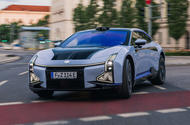
Accomplished luxury car from young Chinese brand leans a little too hard on digital tech and double-take styling
HiPhi, the emergent automotive arm of ‘big tech’ group Human Horizons, is this week’s most important Chinese car brand you might never have heard of. Founded in 2017 from a will to create a new, Chinese-owned and -operated, truly forwards-facing luxury car brand, it is already on the cusp of launching its third model in just six years. That’s a phenomenal rate of expansion by any reasonable measure and probably wouldn’t have been possible anywhere other than The People’s Republic.Between its two established models, it has already claimed an equally remarkable 25% share of the luxury EV segment of its domestic market. As chief technical officer for the firm and ex-JLR top exec Mark Stanton admits, it doesn’t really need export volumes. “Our audience in China is younger buyers who’re now preferring Huawei electronics to Apple,” he says. “They’re realising that the old ‘west is best’ mentality on luxury goods needn’t apply any more. But our ambition was always to be a proper global brand and that’s where we’re going.”And so, come September 2023, HiPhi will launch its two emergent EV models in Europe – specifically in Norway and Germany, with right-hand-drive UK sales due to follow in 2025. The HiPhi X crossover SUV, introduced in China in 2021, will lead a European sales bid that is likely to remain small in volume, at least until the cheaper HiPhi Y arrives in a few years. But the Human Horizons HiPhi Z (they insist it’s pronounced ‘zee’ not ‘zed’), the newer of the two European debut models, was only launched in China last year and is the more eye-catching prospect – for good reasons and, erm, some others.This is a five-metre, all-electric, four-door shooting brake GT with 663bhp, an electric range that’s likely to be WLTP certified at nearly 350 miles, and an aesthetic that’s part Japanese manga performance aggression, part BMW i-brand tribute act and part love song to the digital technology that Human Horizons considers – rightly or wrongly – the bridge to the mobility of the future.It looks a bit of a mish-mash, covered in flashing LED light strips and bulky sensors – a little like some bargain-bin transformer toy that’s been blown up to full life size. If you’re a start-up EV maker, shouting more loudly with your design than the legacy brands, as you need to just to cut through, takes some doing at the moment – and that explains plenty about this car. So you’ll certainly notice the HiPhi Z, but Taycan-handsome, it isn’t.On the inside, the digital tech is wielded even more prominently. You enter via a motorised door, and the driving position is a little high for something that should really feel low and enveloping, with head room quite tight by luxury car standards (although the second row is roomy enough for adult passengers). Material quality is good, though – better by far than Tesla’s was at the same stage of its development – and the ambience quite rich and inviting. The cabin’s central focal point is a 15.0in touchscreen infotainment system, called the HiPhi Bot, which is mounted on a robotised arm so as to automatically pivot towards the driver when it senses that you’re looking at it, or alternatively towards the front passenger. The system has great responsiveness and clarity, and really doesn’t need the gimmicky pivot mounting, which adds little to its usability. But its inclusion is typical of a car that does digital tech to excess, presumably for those who like the very latest mobile phone with the biggest screen and fanciest camera, and the biggest OLED TV their living room door can admit.On the road, the HiPhi Z does a lot quite well. Fast, genuinely rangey (our test car was advertising a real-world 350 miles on a charge) and commendably refined, it has the polished plushness of feel that you might expect to have eluded a brand with such little experience.It doesn’t seem to have a surfeit of handling dynamism. Adaptive air suspension and four-wheel steering make it wieldy when manoeuvring, and controlled in its handling at speed, But while our test route gave little chance to explore the car’s underlying chassis manners, it didn’t feel especially agile or entertaining. The firm admits that it isn’t aiming to beat the very best-handling GTs on the market with this car, but it does seem as if it could have been slightly bolder with its electronic chassis calibration.Without all that digital tech and the statement styling, would the HiPhi Z have anything else to make it stand out? Or would so many people just see an expensive EV from a brand they don’t know, with a very respectable if slightly characterless driving experience, and little to differentiate it?You can probably guess what I’d see – accomplished as this car clearly is in some ways. But if, unlike me, you’re a bigger fan of digital technology in automotive applications, you might well see a whole lot more.
Source: Autocar